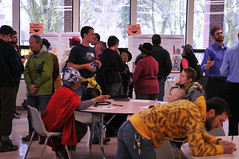
free kettle corn and childcare
you get a great turnout.
(Photos © J. Maus)
The open house for PBOT’s North Williams Avenue Traffic Safety Operations Project drew a large crowd to the Immaculate Heart Catholic Church on Saturday. The event was the first time the public got a chance to see how PBOT and their Stakeholder Advisory Committee (SAC) would tackle the traffic issues on this vital neighborhood street that has become the second busiest bikeway in the entire city.
PBOT and project consultants did an excellent job setting up the event, making it easy to leave input and having plenty of staff on hand to answer questions and explain the project. At one station, attendees were asked to place up to three notes at areas of concern. See the level of participation in the photo below taken by Steve Bozzone (the area shown is between N. Beech and Shaver):
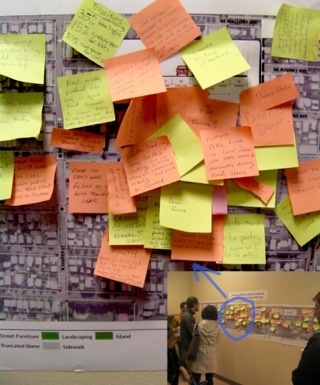
It’s not surprising that this project has stirred so much interest. Williams runs through the heart of a neighborhood that has seen significant shifts in demographic — and transportation — trends in recent years. This project isn’t just about vehicle lanes and parking, it’s about change. And change isn’t easy or exciting for everyone.
One long-time Williams Avenue resident told me she didn’t think anything should change. “This is all different,” she said, pointing to the posters with concept drawings on them, “Change is hard. It works just fine for me.”
But Williams doesn’t work “just fine” for everyone. The current bikeway leads to nasty door-zones, bus-bike conflicts (a.k.a. “leapfrogging”) and the 5-6 foot bike lane simply isn’t big enough to handle the volume (and varying speeds) of bike traffic.
PBOT shared some interesting ways to deal with these issues. Here’s a proposed way to handle bus/bike conflicts that would create a bus stop platform in a parking lane with a cycle-track running curbside:
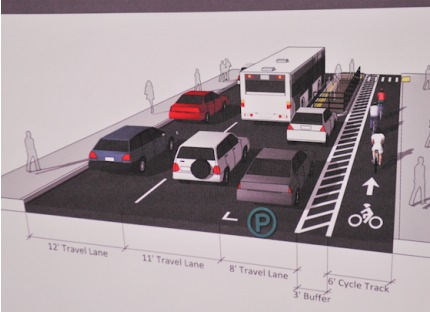
As for expanding bike capacity, I like this dual bike lane idea (which already exists heading west onto Hawthorne Bridge).
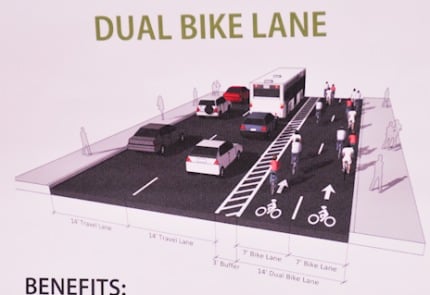
Like I reported last week, in all but one segment of Williams, PBOT is likely to re-allocate existing lanes in order to make more room for bike traffic. However, in arguably the most important section — the dense commercial district from Cook to Skidmore (PBOT calls it Segment 4) — PBOT is leaning toward simply adding new traffic signals (to manage speeds).
Segment 4 currently has two vehicle travels, two on-street parking lanes, and one five-foot bike lane. PBOT’s reluctance to alter that layout is due to concerns about congestion and push-back from businesses who are afraid they’ll lose on-street parking.
“If the community says, ‘we want a more robust bike facility,’ we’ll certainly listen to that.”
— Rob Burchfield, City Traffic Engineer
Three new signals would mean six straight blocks of signalized intersections. This would give PBOT the ability to dictate vehicle speeds. That’s a nice improvement, but speed of cars isn’t the only issue that makes biking feel unsafe in this area. Not only that, but there’s no money available to pay for any new signals.
Many people made it clear at the open house that the preferred solution in Segment 4 would be to re-allocate roadway space — going from two vehicle lanes to one — in order to create a larger and more comfortable bikeway.
City Traffic Engineer Rob Burchfield said whatever they do will come down to “finding the right balance” between community feedback and operational issues. “If the community says, ‘we want a more robust bike facility,’ we’ll certainly listen to that.”
Judging from the outpouring of support for making Williams one-lane in this section, I think PBOT is listening now.
Steve Bozzone, a citizen activist with Active Right of Way who has been rallying support for a better bikeway, said after the open house, “If we don’t end up with the best Williams for walking and biking, it won’t be for lack of public support.”
Open House attendee Mary Bennett doesn’t even bike on Williams and she says reducing it to one lane would be, “so much more civilized.” “I’d like to see a single lane,” she said, “The more opportunity vehicles have to pass, the faster they’ll go.” Bennett wants more space for the bikeway because she fears hitting someone on a bike when she opens her car door.
But, as mentioned above, not everyone at the open house is eager for these changes.
Before I left the open house, I sat down with a lifelong Williams area resident to hear a different perspective on the project (thanks to one of the project’s consultants for pointing her out to me).
Sharon Maxwell-Hendricks grew up in the neighborhoods around N. Williams Avenue. She’s been a member at the Life Change Christian Center (Beech and Williams) for 23 years and has owned a business on Williams for 13 years. Maxwell-Hendricks feels like these changes are being driven by a small group of “bicyclists” and that bicycle traffic should use N Rodney (a side-street a few blocks over) because reducing access for motor vehicles on Williams will hurt area businesses.
“It feels like a small percentage of bicyclists are driving the changes.”
During our conversation, Maxwell-Hendricks made several references to the term “bicyclist group,” as the ones pushing for these changes, so I asked why she used that term.
“Because that’s what I feel like it is. Because, it seems like it’s [bicycling] lately been a part of the whole gentrification and urban yuppie groups and something that’s being more pushed, not because it has momentum and everyone’s like, ‘It’s great! wow, we want to do this!’
I don’t feel like they’re including everybody. And then the comments I see in a lot of the newsletters… They always say things that are so negative and derogatory… Like low-income people can’t afford bikes. I’m going, ‘huh?’ There’s a disconnect. It seems like they’re in their little clique and they’re connecting the dots for themselves and they’re the ones that are creating the elite.”
Do you see people bicycling in your neighborhood? I asked.
“Yes.”
Do you feel they’re part of that “group”?
“I don’t know that. I can’t say that. That would be wrong. That’s just like me saying, I see a young man walking down the street and, because he’s black, he’s a gang member.”
Maxwell-Hendricks is also concerned that a bike-centric street might negatively impact motor vehicle access and hurt local business development.
“If a business is looking for a high volume of customers, than how’s that going to happen if it’s just all bicyclists?… What if you want people to be able to get there and their mode of transportation is not a bicycle?… How do those people get to your business if the street is not inviting to them? If there’s no parking, where’s the parking for these businesses? Those are all valid and huge concerns for people who are not bicycling.”
I think Maxwell-Hendricks understands that motor vehicle access will not completely go away in any scenario being considered. But even so, her fears are deeply rooted in an opinion that, as a matter of culture, people of color in North Portland will simply never take to the streets on bicycles except for things like Bridge Pedal recreational rides.
“If I’m going to ride a bike to a location, how is that going to make me look when I get there? My hair’s going to be all screwed up, it could be raining and wet, people want to feel comfortable when they arrive to the location. It just, it’s not very conducive to a majority, as far as, what they would consider a viable transportation mode…
The whole thing about hygiene and personal presentation once you get somewhere, you know, that is really huge.”
I tried, somewhat in jest, to share with Maxwell-Hendricks that, if we created more comfortable bikeways (like the ones being proposed on Williams) people wouldn’t have to wear helmets and could bike with their Sunday church outfits on. She wasn’t persuaded, “I want to be safe when I’m riding a bike. I’m not going to put on some high heels… No, there’s more to it than that.”
Maxwell-Hendricks is right. There is a lot to it.
PBOT and project staff will now take all the feedback from the open house to help inform the next round of design options. Stay tuned to BikePortland and check out the official project page for more information.


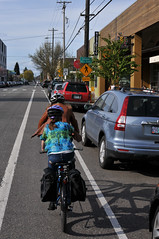
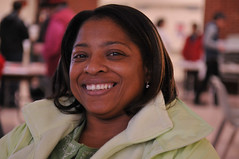
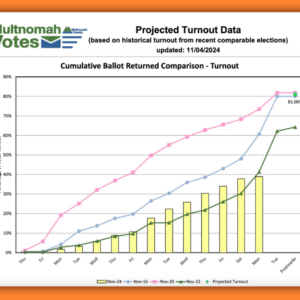
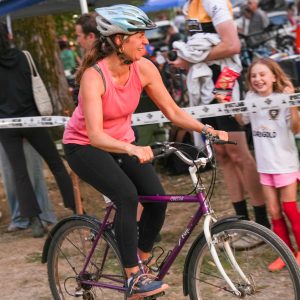
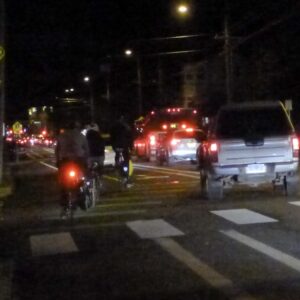
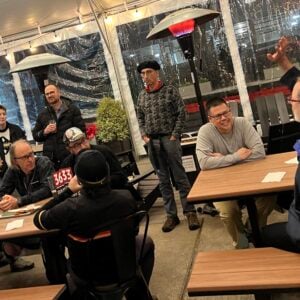
Thanks for reading.
BikePortland has served this community with independent community journalism since 2005. We rely on subscriptions from readers like you to survive. Your financial support is vital in keeping this valuable resource alive and well.
Please subscribe today to strengthen and expand our work.
Jonathan:
How would you compromise with Maxwell-Hendricks’ position? Or do you feel like you shouldn’t compromise?
Obviously there needs to be some degree of compromise, that’s what community involvement is all about and that’s what makes Portland, Portland.
I think it’s a matter of equity and using our right-of-way in the best way possible. Routing bike traffic to Rodney isn’t going to happen. Williams is a major bike street and it should be a major bike street (it shouldn’t be as major of a car street as it is, but people use it as a regional arterial and as a bypass from I-5), so to me, the question isn’t whether or not we provide bike access, it’s how good do we make that bike access.
Given our 2030 Bike Plan and other rhetoric and requirements around transportation planning, it’s clear that existing bike access isn’t good enough. It’s also clear that many in the community do not agree with Maxwell-Hendricks. How do we weigh all these opinions? That’s up to PBOT to sort out.
The final decision should be based on a number of factors, I think Sharon’s position is just one of many that need to be taken into account. In the end, hopefully the best option will come to the fore and be implemented.
I have to disagree with Sharon about the cyclist cliche in the community. I’ve only lived in the eliot area for 1 year and I’ve seen so many people with bikes either for commute or recreational activities. I personally think she is wrong on calling the cyclist cliche small or even a cliche. Everyone can get decide to commute by bike or by car, it is a choice. If it is about your budget then the low income residents should invest in a bicycle rather than a vehicle. No one on a bike is going to tell you to drive a car instead. The change to N. Williams is about safety. The neighborhood is changing, its gotten more popular, and vehicle traffic will increase no matter what. That means more likely an accident will occur. And more people are biking so that means the demand needs to be met. I also have to disagree with her on the possible negative impact on business because of the parking. Remember, only about 8+ cars can park along one block in segment 4. And the only time they are full is when there is a street event (PIX Bastille Day example) or during dinner rush hour. If you take away those parking spots and build bike lanes and parkways. People will bike there instead of driving. Maybe they should do a survey at all the businesses on Failing and N. Williams, see how many of their customers did not drive there.
One of the biggest reason I moved into Eliot-Boise neighborhood is the N. William/Vancouver bike lane and its diversity. It is a gentrifying neighborhood, I am not Caucasian/white myself and I’ve heard several complains from local african american residents. Gentrification has its pro and con. But I think you can use bicycle to create a connection between race and cultural barriers. One afternoon I was on my cargo bike on the way home from lunch. I stopped by a house to check out its garage sale. An Afircan American lady and two children were on the patio. The children were in awe of my cargo bike. I asked her if the children want to go for a ride on my bike around the block. She said no since she doesn’t feel safe and I didn’t have an extra helmet. The two kids begged her. In the end no ride happened but we talked about the history and the community of the neighborhood. I left knowing one of my distant neighbors and a set of awesome wine glass.
That would never have happened if I was driving a car.
Jonathan: I appreciate that you feel the need to compromise, but you didn’t exactly address my question. If the removal of one vehicle travel lane is your position and status quo is Maxwell-Hendricks’ position, what sort of compromise would you be willing to make in order to find a middle ground?
I feel that re-allocation of one of the four lanes is essential. I don’t think we should have two parking lanes and two standard vehicle lanes, while the bike lane remains a mere 5 feet.
Just because there are different positions on something, doesn’t mean a compromise is imperative.
This is one person’s position, this isn’t the same as two governing bodies trying to hash something out.
Traffic projects aren’t done by votes, they are done by a careful balance between what is needed from an engineering standpoint, what we can afford, what is politically feasible, what the community wants, and so on.
So essentially what you’re saying is that your original answer to my question wasn’t actually true. That’s fine, I’d rather have an honest answer than the usual “I hear what you’re saying” line.
cyclist,
That was an honest answer and I don’t appreciate you suggesting that it wasn’t…. Just consider my second comment an extension of the first ;-).
Sorry, I thought your second comment pretty clearly set out the position that compromise was unnecessary:
“I feel that re-allocation of one of the four lanes is essential. I don’t think we should have two parking lanes and two standard vehicle lanes, while the bike lane remains a mere 5 feet.
Just because there are different positions on something, doesn’t mean a compromise is imperative.“
If you’re unwilling to part with the idea that Williams be reduced to one travel lane I don’t really see where the compromise comes from.
So I guess back to my original question: if you do believe in creating a compromise, what would that compromise look like? What are you personally willing to take off of the table?
I had a lot of great conversations with all sorts of folks at the open house, and it seems some of the anti-bike concerns are a projection of a much deeper misunderstanding about how the bicycle is being used for transportation in Portland, and less about the actual Williams project. We still have a long road ahead of us in explaining the ins and outs, meanwhile the image of the elite-yuppie-scofflaw-freeloader cyclist continues to foment.
I had the opportunity to share my own experience with folks who had outspoken negative opinions about people who ride bikes: I ride a bike because I can’t afford a car, and transit is expensive. I enjoy riding my bike, but for me and many Portlanders, it’s a form of conveyance that comes from economic necessity. I’m priveleged to have my destinations within a 15 mile radius of my house, and I understand not everyone can ride a bike for transportation.
We have many disconnects in our city and public process, and I’m glad Ms. Maxwell-Hendricks is speaking to them.
I agree. I’d love to have more meetings and conversations with Sharon and others where we could get at all these issues. Like often is the case, bicycles are a socio-political football that is very easy to throw around. It shouldn’t be that way. Bikes are the most community-oriented, equitable form of transportation ever devised.
I’m not sold on the premise that adding signals and slowing traffic increases safety. Signal timing slows some people down (those at the front), but it also encourages those farther back to speed even more than they otherwise would, as they attempt to catch up to the green wave. All it takes is a few reckless individuals running yellows and picking up speed to catch the green lights, and overall safety of that stretch of Williams will be even less than it was before.
I wonder about that too, as people will definitely up their speed to hit the lights.
I wonder if those signs that flash at you when you’re exceeding a certain speed would help to slow things down, like the one near the Market Pub outside of Multnomah Village, on that s-curve street.
And if the lights are timed so that a substantial portion of the bike traffic also has to stop and wait out all of these lights it will bunch up cyclists, causing more passing in the traffic lane and will encourage people to proceed on Red when there isn’t cross traffic creating more animosity with autoists.
not if the timing is for 12 mph as it is downtown
it’s interesting to hear someone talking about a modern american street not being inviting enough to those who drive a car.
yeah especially since this “street” more closely resembles a drag strip.
I’ve been thinking about this from some other recent blogs, especially the article I read last weak about how younger people (presumably with disposable income) are much more attracted to complete neighborhoods with multiple transportation options.
We have a long way to go and we need to find a way to engage business owners like Maxwell-Hendricks and their customers.
I am thinking of Three approaches. The first is a good entrepreneur must always be looking to adapt to changes and take advantages of new opportunities. So thing we can offer Businesses is “Okay, here is this new opportunity. There are customers coming by you business on bicycles and there are a growing portion of the traffic on your street. Lets look at how you can bring this traffic in as customers.” The second approach is to engage in a discussion of car traffic and flow. “How many of you customers come from the neighborhood (~ 1 miles around) and how many come here from across town? How many cars passing by to avoid MLK or I-5 are likely to stop to frequent your business? How does the traffic from people using Williams to bypass MLK and I-5 impact your regular customers? How many of your customers would be more frequent if Williams was a quieter street?” Third talk about what could develop on the vacant lots and in the empty buildings pointing out what is happening in other areas. “How long have all these blocks and storefronts been empty? How many new businesses have successfully opened in the area in the past 10 years? How would you business be impacted if new businesses were to become established that located here partly because of the complete street model? ”
Of course it depends on the kind of business. However, the businesses on that stretch seem to me to be adaptable. Mostly restaurants and boutiques and small shops. These businesses are mostly located here because they a) low rents, b) neighborhood and c) they aren’t a good fit for strip malls on arterial streets. Essentially their existing customers probably come because it is close or because it isn’t a strip mall on a a high traffic street or because they are very loyal to that business.
I enjoyed the open house, I put in some comments, and chatted with a lot of interesting people about the problems and possible solutions.
With regards to the “not enough space for cars” concerns, whenever a car driver chooses to bicycle, there’s always more room on the road for the remaining cars. Even if bicycle traffic requires a few motor-lanes to be converted to bike lanes, it’s a net gain for motorists because a bike lane is only 5′ wide and a care lane is 10′ wide.
If half of the drivers in this city started bicycling, and 1/4 of existing car traffic lanes were converted to dual bike lanes, the remaining cars would have much more lane space and many more parking spaces than they have now.
Ted Buehler
I’m optimistic that we’ll see some major improvements made to Williams. Kudos to PBOT, Alta, Michelle Poyurow and the Williams Ave Advisory Committee for putting this all together.
As I posted in the previous thread, I was pleased to see “Dual Bike Lanes” as an option. (3rd pic from the top in this post). I think the having two bike lanes side by side is essential for smooth flow of bicycles on Williams. I ride Williams at least once a day, sometimes in a big hurry and sometimes pulling a heavy trailer. Having a fast lane and a slow lane would make this street friendly for me in both of these riding situations.
And, for folks that weren’t able to attend, be sure to send in your comments to Ellen Vanderslice at PBOT. Contact info at the bottom of this page — http://www.portlandonline.com/transportation/index.cfm?c=53905
Ted Buehler
Given that Williams Ave passes through a mixed residential/commercial zone perhaps a monetarily wise policy would be address the on street parking issue as a function of freeing up road space permanently.
In Zone 4:
How much of the road space currently utilized as on-street parking is absolutely needed?
How much of the road space currently utilized as on-street parking is used by adjacent residents? Residential use of on-street parking is the #1 detractor from on-street commercial parking.
Could an “improvement” fund be used to help on-street parking users develop off-street parking on their own lots? Legal or not, the money spent making auto user’s properties suitable for storage of their vehicles rather than continuing to allow on-street parking will likely be less than the costs for convoluted engineering, rerouting and all the legal battles in appeals to undo all the funding already spent.
Everybody in my neighborhood has 2-car garages and driveways, and they still seem to collect enough cars that they have to permanently park some in the street.
Is there any research available that differentiates the patrons of the aforementioned businesses by mode of travel? The businesses don’t need to care how folks travel past their shop, but those who do stop are of great importance.
Was there any discussion of limiting Williams to more local traffic flow? By this I mean making an effort to short circuit traffic using it as an I-5 bypass from Broadway? If auto traffic was narrowed from the start and limited to more local traffic this would make for slower speeds and reduced car numbers and it would be much easier to both preserve parking, add bike facilities and drop one travel lane. I could see this being accomplished by reducing Williams to a single lane for a block or two just north of Broadway, perhaps even to a “bus/bike only” lane. Drivers heading into NoPo would take Interstate, MLK, or Williams (via Victoria) if not I-5.
Could this be done with something as simple as “No Left Turn” restrictions?
All you have to do is make the time cost for I-5 diversions to side streets too high. This can include targeted diversions from off ramps making side streets inaccessible.
Do you mean like how eastbound W. Burnside has no left-turns into the pearl district? I don’t think that would be very effective over such a long stretch of road. I think physically blocking all but the rightmost lane on Williams by extending the I-5 ramp curb or just north of the gas station would be solutions, and making that single lane bus/bike only for a block or two. This keeps mass-transit running fine and makes it a nice bike street and doesn’t present too large a barrier to NoPo residents who are likely to use I-5 or Interstate or MLK anyway.
Given that businesses are concerned with on-street parking, I think the first PBOT concept with 2 car lanes, a parking lane, and a buffered bike lane is a good place to start. Here’s what I would change:
1. Two car lanes are really not necessary, except at intersections. They should use the left lane as a parking/travel lane, similar to Tacoma in Sellwood. Most of the block will be parking, with 40-50ft before and after each lane for turning or passing busses.
2. To avoid right hooks and delaying cars when busses stop, move the bus stops forward past the intersection. The space used by the platform can be a right turn lane for cars, placing them adjacent to the bike lane.
With these changes, auto traffic will still flow well, but at a reduced rate. The businesses get their parking, and bikes get a buffered bike lane without the increased right hook risks.
Revision to point #1: *intersection instead of *lane
cyclist,
Sorry I have not been clear. I don’t think PBOT should compromise in terms of the lane re-allocation issue. If they keep conditions as-is and simply try to manage this with traffic signals and “main street” traffic calming improvements, it will be a major missed opportunity.
Yes. Compromise is important. Does it have to happen in every project in every situation? At some level, perhaps… But in terms of this situation of the lane allocations, I don’t see how a compromise can happen. Bottom line is this street does not have the level of bike access that it should have and that needs to change.
The one option I haven’t heard back from PBOT about — and the option that Sharon Maxwell-Hendricks said she supports — is a peak-hour solution. She wants peak-hour to stay as-is for auto traffic, but then would be open to enhancing the bikeway during off-peak hours. I’d like to know more about that option. Perhaps that’s a compromise, but at this point, I don’t really like it as a solution.
Another good point is that compromise, if and when it occurs, does not have to occur equally in all aspects of the project. I realize in this case we’re focusing exclusively on Segment 4 – confining just to that, there are still options available. The best for all parties is to remove a travel lane. Removing a travel lane will reduce throughput on Williams for motor vehicles during the rush hour. Since Williams is a neighborhood collector, NOT an arterial, this is desired. By making the road less convenient for through traffic, a higher percentage of those on the road will be those most inclined to stop at the businesses in question – the traffic which is there now to bypass the slow spots on I-5 is impatient, and not looking to stop at the businesses on Williams.
I don’t see how you can say you’re willing to compromise with Maxwell-Hendricks’ position while at the same time saying you don’t think there should be a lane allocation compromise (which is th entire case, is it not?). Maxwell-Hendricks’ offered her own compromise solution, if you support compromise what is yours?
There’s nothing wrong with saying, “I don’t think we should compromise on this issue”, but that wasn’t your initial response.
I support compromise, but I don’t think we should compromise on the lane issue.
Do you mean you support compromise as a general concept (who doesn’t?), or that you support compromise with Maxwell-Hendricks’ position? If the latter, what shape would that compromise take?
You’re hearing the word “compromise” in the same tone as “collaborator” in France during WWII occupation, right?
in order to find compromises, people have to be clear on what they actually want, and they have to be working from accurate information.
there may be a number of things ms maxwell-hendricks believes she wants, but let’s look at not giving up onstreet parking, because that is actually the only thing that comes through from the stuff jonathan has quoted here. what she wants is for customers to have access to the businesses along williams. she believes that the existing allocation of onstreet parking is necessary, but she may be mistaken.
and let’s look at what the “small group of bicyclists” wants. they want to be able to use williams to get from here to there without getting clipped or doored. some of them may believe that it is necessary to remove onstreet parking here and/or there to achieve this, but again, they may be mistaken.
what about removing one of the two travel lanes through segment 4? would this impair customer access to the businesses? again, maybe not. the volume of motor traffic through here requires two lanes only a couple of hours a day, and during those couple of hours a big chunk of the motor traffic is people coming off 405 and heading to an arterial, using what is supposed to be a neighborhood collector as a cut through.
so there is plenty of room here for people to accommodate each other.
if what ms maxwell-hendricks or someone else “wants” is for cyclists to use rodney instead, that is a nonstarter, and it has nothing to do with compromise or not compromise. rodney does not and cannot serve the same function as williams, and it is completely unreasonable for someone to tell “those cyclists” what choices they “ought to” make.
My un-substantiated guess is that parking used for commerce is at a minimum during peak traffic times: ie “Rush hour”.
The imagined concern of cyclists not stopping to spend money while using the neighborhood as a thoroughfare/bypass should be equally applicable to motorist users of Williams Ave.
The only realistic new source of customers for businesses with limited auto parking is customers who show up without autos. This means walking, cycling and mass transit.
To me then the compromise is education: education that non-automotive customers are just as real as those that park their status symbol all over the bike lane and sidewalk. These non-automotive customers will also have disposable income not spent on a rolling status symbol.
One conclusion from the gathering was that we have the chance to develop Williams into a world-class bike corridor, something that could be a model for things to come in Portland and the country.
Transforming Williams into a street with a dedicated cycle track would do this. The amount of bike traffic justifies the effort and building it would be a self-fulfilling effort that would create even more bike traffic.
The proposed cycle track option would lose one lane of parking. I don’t think this is significant. My theory about car parking is that it is indeed necessary for a business to generate customer traffic. However, one lane of parking would still be sufficient. Standard motorist behavior is that even though there never is any parking if there is simply the expectation of parking (even if totally unrealistic), people will drive by a business, find no spaces and then park in a neighboring side street.
More rush hour traffic should be diverted to Interstate, (via the Greely exit?). This was the historic highway before I5 went in.
A few thoughts/questions:
1. How much bike parking is available on that stretch of Williams? Ms Maxwell-Hendricks isn’t going to see much business from people on bikes if there isn’t much parking.
2. What kind of business does she have? If it’s a furniture & large appliance store she isn’t going to get much business from bike traffic, so of course it wouldn’t be something that she would see as useful (ignoring the fact that someone on a bike might stop in to look for a new couch, etc).
3. A peak-hour solution isn’t going to work because the busy time for automobile traffic is probably the busy time for bike traffic.
4. My vote: Leave the parking, remove a traffic lane.
The right “peak-hour” solution is to turn one car parking lane into a travel lane at peak hours only, while the cycletrack remains all the time. This is the solution used by many cities (including Los Angeles) to move more cars at the expensive of parking during peak hours.
So, during peak hours, there would be 2 car travel lanes, 1 car parking lane, and a cycletrack in the debated segment. During off-peak hours, one of the car travel lanes would be used for car parking instead.
This would mean that most customers of local business would have just as much parking as before, while most drivers would have as much lane space as before (assuming business is spread throughout the day, while traffic is certainly concentrated at rush hour).
I like this idea… a LOT! *This* is what I’d call a good compromise. I usually bike through that area at non-peak travel times, and the car lanes are never anywhere near capacity, at least from my limited observation.
A left side bike lane or dual bike lane or cycletrack all the way to Killingsworth would be really great. That Section 4 is the tightest spot, with the most doors and most pedestrians. How does adding lights and making it more like SW Broadway help???
I think adding lights would be a disaster. There’s already a lot of congestion and problems at lights – cars and bikes both speeding up to make yellows, right turns, people starting and going different speeds. It’d just add to the mess.
I’m pretty sure there have been multiple studies done that show that adding stoplights doesn’t increase safety, and doesn’t really lower speeds. I’m very disappointed that this is PBOT’s initial reaction, I thought they were better than this.
The bike lane’s too narrow, it’s hard to pass one person, and in the summer people seem to love riding side-by-side with their friends.
I vote to remove the left side parking and add a cycle track.
i disagree. the reason people are speeding up to catch yellow lights at fremont or shaver or skidmore is that there is no rational timing between lights spread out over such distances. if you had signals at five or six consecutive intersections, timed so that it was pointless to go faster than 12 mph, you would not have this problem.
My experience with traffic lights as speed control is that cars merely accelerate to each stop light.
Many of the lights are timed downtown. If you follow the timing according to the speed limit you can really sense hostility from others and a few will make reckless lane changes. (And, if you’re on a bike obeying the speed limit this can really agitate a motorist.) It really pisses me off how people senselessly waste gas this way.
why not street parking on the left (7′), one 11′ travel lane, street parking on the right (7′) and a full cycle track between the parking and the sidewalk (that gives you 11′ for the cycle track and painted buffer zone, assuming dual 12′ sidewalks)? i’m pretty sure i didnt see this option.
i like the street parking as a physical buffer for the cycle track (and peds on the sidewalk) which also slows traffic. you’ll need on-street parking if you want less off-street parking (allowing land to be used for land uses that actually contribute to the neighborhood like housing, offices, restaurants and stores).
I dropped into the open house because I’m a resident who lives on Williams and bike through the area under consideration every day. Traffic lights would not fix the issue of having a narrow lane lined with car doors.
If they can’t remove a car lane or parking, in the busiest segment, I think bicyclists should get in the habit of abandoning the bike lane altogether and simply taking the car lane. That seems the safest solution, in my opinion and it will communicate that the current striping isn’t safe for bicyclists, pedestrians, or even drivers trying to get out of their cars.
I’m at Tasty n Sons for lunch, on N Williams between Beech and Failing (Segment 4). They have a new bar area that faces Williams.
I counted traffic from 2:55 to 3:00.
Bikes: 12
Cars: 37
Bikes are 25% of the traffic here today. Off peak travel time.
Ted Buehler
I appreciate that you included Ms. Maxwell-Hendricks’ perspective. To me, her concerns also spoke to the changes on Williams Avenue as it relates to “gentrification”. The Williams Avenue of yesteryear (jazz mecca and heart of Black Portland) can hardly be seen in the Williams Avenue of today (once called “best bike street” in the city). I am glad that she, as a long-time resident and neighborhood business owner, is involved in the process and I think “we” (the city, I’m not sure who else) should be actively doing outreach to be sure that the historical residents’ perspectives are heard.
I am afraid of the Williams bike lane now as a family rider. The lane is too narrow and there are a lot of opening doors. I would opt to take a lane rather than ride in the bike lane.
In lieu of riding Williams, I regularly ride Rodney or Commercial north from Fremont to Ainsworth. I would like to see one or the other become full neighborhood greenways to provide an alternative to Williams.